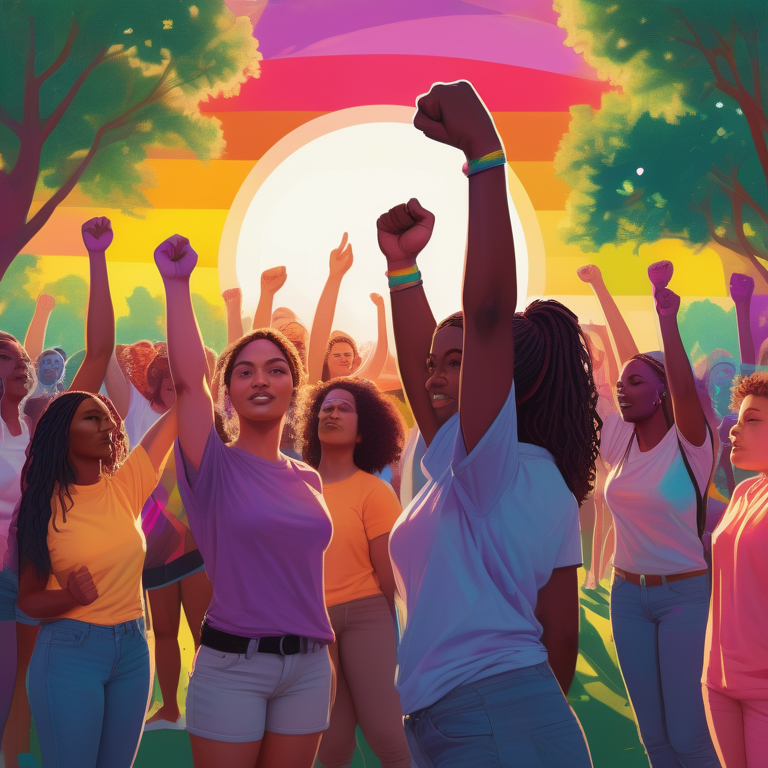Harnessing Digital Platforms in LGBTQ+ Women’s Activism

Key Highlights
- Digital activism has revolutionized LGBTQ+ women’s activism by providing a platform for mobilization, organization, and advocacy.
- Social media has played a crucial role in amplifying, building communities, and promoting social change.
- Successful campaigns and the use of hashtags have showcased the power of online activism in creating awareness and driving social movements.
- However, digital activism also faces challenges such as censorship, surveillance, and the need for inclusive advocacy.
- Virtual communities and collaborations across borders have strengthened networking and solidarity among LGBTQ+ women online.
- Various digital platforms and tools empower LGBTQ+ women to raise their voices and create meaningful change.
- Legal and ethical considerations, such as privacy laws and ethical guidelines, are important in navigating the digital activism space.
Introduction
Digital platforms have transformed the landscape of activism, providing a powerful tool for marginalized communities to raise their voices and fight for social change. In the realm of LGBTQ+ women’s activism, digital platforms have played a crucial role in empowering individuals, building communities, and challenging societal norms. From grassroots movements to global networks, digital activism in the digital environment has revolutionized the way LGBTQ+ women advocate for their rights and create inclusive spaces online. As Reference Nartey Nartey (2022a :2) maintains, “digital activism and the digital environment serves as a way to center the voice and agency of minority groups, including positive self-representation and their solidarity formation for group empowerment.” In the following paragraphs, we will delve deeper into the impact of digital platforms on LGBTQ+ women’s activism and the challenges and opportunities it presents.
This blog delves into the evolution of LGBTQ+ women’s activism and explores the impact of social media on advocacy efforts. We will examine successful campaigns and case studies that highlight the power of digital platforms in amplifying voices and building communities. Additionally, we will discuss the challenges and opportunities in digital activism, as well as the importance of networking and solidarity among LGBTQ+ women. Finally, we will explore the tools and platforms that empower LGBTQ+ women to make a difference and the legal and ethical considerations in the digital activism space, particularly in light of the UK drug spiking incidents in October 2021.
Digital platforms have become a catalyst for change, allowing LGBTQ+ women to connect, organize, and advocate for their rights in ways that were once unimaginable. By harnessing the power of digital platforms, LGBTQ+ women are driving social change and creating a more inclusive and equitable world.
The Evolution of LGBTQ+ Women’s Activism
LGBTQ+ women’s activism has evolved significantly over the years, embracing digital platforms as a means to effect social change. What started as grassroots movements advocating for gender equality and human rights has now become a global network of activists fighting for LGBTQ+ rights. The emergence of digital platforms has provided a new avenue for activism, enabling LGBTQ+ women to connect, organize, and amplify their voices on a global scale. These digital platforms have become powerful tools in driving social change and challenging societal norms.
From Grassroots to Global: A Historical Overview
LGBTQ+ women’s activism has its roots in feminist movements that fought for gender equality and human rights. These grassroots movements aimed to challenge the patriarchal systems that perpetuated inequality and discrimination. Over time, these movements expanded their scope to include LGBTQ+ rights, recognizing the intersectionality of gender identity and sexual orientation.
With the advent of digital platforms, LGBTQ+ women’s activism transitioned from local grassroots movements to a global network of activists. Online spaces provided a platform for LGBTQ+ women to connect, share experiences, and advocate for their rights. The digital world became a powerful tool for organizing protests, raising awareness, and effecting change on a global scale. Today, the use of online platforms remains a crucial aspect of LGBTQ+ women’s activism, allowing these groups to reach a vast national and international audience and, most importantly, communities that live in more rural areas and in which women are most vulnerable.
The Shift Towards Digital Platforms: A Timeline
The shift towards digital platforms in LGBTQ+ women’s activism can be traced back to the rise of online activism in the late 20th century. As internet access became more widespread, activists started utilizing digital media platforms to amplify their voices and advocate for their rights. Online activism provided a new avenue for LGBTQ+ women to connect, organize, and mobilize for social change, marking a significant shift towards the use of digital media in feminist activism.
Social media platforms, such as Twitter, Facebook, and Instagram, played a pivotal role in the digital activism movement. These platforms allowed LGBTQ+ women to share their stories, organize protests and campaigns, and build networks of support. Hashtags became a powerful tool in creating online movements and raising awareness about issues affecting LGBTQ+ women. As platforms like Twitter have undergone changes, with users migrating to other platforms and either shutting down or partially using their Twitter accounts, the landscape of digital activism has also shifted. This shift can be seen in the timeline of Twitter’s evolution, from its acquisition by Elon Musk to its rebranding into X, and the impact it has had on the LGBTQ+ digital activism community, as well as the rise of new platforms like YouTube as a tool for activism.
The timeline of LGBTQ+ women’s activism on digital platforms showcases the growth and impact of digital activism. From the early days of online forums and blogs to the widespread use of social media, digital platforms have revolutionized the way LGBTQ+ women advocate for their rights and create change in society.
Understanding the Impact of Social Media on Activism
Social media platforms have had a profound impact on LGBTQ+ women’s activism, providing a space for amplifying voices, raising awareness, and mobilizing for social change. With the ability to reach a global audience, social media platforms have become powerful tools in the fight for LGBTQ+ rights.
One of the key advantages of social media is its ability to amplify voices that were previously marginalized. LGBTQ+ women can now share their stories, experiences, and challenges with a wider audience, breaking down barriers and increasing visibility. Hashtags have played a crucial role in this process, allowing LGBTQ+ women to connect and share their experiences under a common banner. Social media posts have transformed activism by creating a sense of community and solidarity among LGBTQ+ women, empowering them to advocate for their rights on a larger scale. This is especially important for LGBTQ+ individuals who may feel like they are not represented in mainstream media, as social media allows them to showcase their lives as ordinary people with everyday problems.
Amplifying Voices: Case Studies of Successful Campaigns
Case Study 1: The It Gets Better Project
- The It Gets Better Project, launched in 2010, aimed to provide hope and support for LGBTQ+ youth facing bullying and discrimination.
- LGBTQ+ celebrities and individuals shared their stories via online videos, offering messages of encouragement and resilience.
- The project gained widespread attention on social media platforms, reaching millions of young people and fostering a sense of community and support.
Case Study 2: #BlackTransLivesMatter
- In response to the ongoing violence against Black transgender individuals, the #BlackTransLivesMatter movement emerged.
- Activists utilized social media platforms to raise awareness about the intersectionality of race and gender identity, and to demand justice and equality.
- The movement gained momentum through powerful visuals, personal stories, and the use of hashtags, amplifying the voices of Black transgender individuals and highlighting the urgent need for change.
Case Study 3: The Trevor Project
- The Trevor Project is a leading organization focused on suicide prevention among LGBTQ+ youth.
- Through their online presence and social media campaigns, they provide resources, support, and crisis intervention services to LGBTQ+ individuals.
- The Trevor Project’s digital activism has helped create a safe and inclusive space for LGBTQ+ youth, saving lives and raising awareness about mental health challenges within the community.
These case studies highlight the power of digital platforms in driving successful LGBTQ+ women’s activism campaigns. By utilizing online tools, these campaigns have been able to reach a wider audience, raise awareness, and create meaningful change.
The Role of Hashtags in Building Communities
Hashtags have become a vital tool in LGBTQ+ women’s activism, playing a crucial role in building communities and connecting individuals with shared experiences and interests. Hashtags provide a way for LGBTQ+ women to find and engage with each other, fostering a sense of community and solidarity in online spaces.
By using specific hashtags, LGBTQ+ women can connect and share their stories, challenges, and achievements. Hashtags provide a platform for collective action, allowing individuals to participate in online movements and campaigns. They also enable LGBTQ+ women to discover resources, support networks, and events related to their interests and identities.
Hashtags have transformed the way LGBTQ+ women build communities and advocate for their rights. They create a sense of belonging and empowerment, allowing LGBTQ+ women to connect and support each other in the digital world.
Challenges and Opportunities in Digital Activism
Digital activism presents both challenges and opportunities for LGBTQ+ women’s activism. While digital platforms have opened doors for advocacy, they also face obstacles such as censorship, surveillance, and the need for inclusive advocacy.
Censorship poses a significant challenge to digital activism, as social media platforms and governments may suppress or remove LGBTQ+ content. Surveillance and algorithm-driven analysis targeting sensitive information also threaten the privacy and safety of activists, especially those from LGBTI communities. This poses a particular threat to women activists within the community, who may face hostile social, political, and legal environments. Inclusive advocacy is essential to ensure that the experiences and voices of all queer people, including those who are activists, are represented and heard.
However, digital activism also provides opportunities for LGBTQ+ women to connect, organize, and effect social change on a global scale. By leveraging the power of digital platforms, activists can reach wider audiences, mobilize communities, and challenge societal norms.
Overcoming Censorship and Surveillance
Censorship and surveillance pose significant challenges to LGBTQ+ women’s activism in the digital space. The restriction or removal of content can silence activists and limit the visibility of their messages. Surveillance threatens the privacy and safety of activists, creating a chilling effect that discourages open expression and engagement.
To overcome these challenges, activists must advocate for and defend freedom of expression in the digital realm. They can utilize encryption tools and secure platforms to protect their communications and identities. It is crucial to raise awareness about the impact of censorship and surveillance on LGBTQ+ women’s activism and push for policies that protect privacy and free speech online. This is especially important in countries like Nigeria, where LGBTQ+ individuals face discrimination and violence for speaking out about their rights.
By fostering a culture of transparency, accountability, and privacy, activists can navigate the digital space more effectively and ensure that their voices are heard.
Leveraging Technology for Inclusive Advocacy
Inclusive advocacy is a fundamental aspect of LGBTQ+ women’s activism, ensuring that the diverse experiences and voices of all individuals are represented and empowered. Digital technology plays a vital role in enabling inclusive advocacy, providing platforms for marginalized communities to share their stories, challenges, and achievements.
For example, transgender people often face unique barriers and discrimination, including increased risk of physical and sexual violence. Digital platforms allow them to connect with others who share similar experiences, creating a sense of community and support. Online resources and tools can provide information and support tailored to the specific needs of transgender individuals, empowering them to advocate for their rights and address issues such as sexual violence. Additionally, technology can be leveraged to raise awareness and educate the public about the prevalence and impact of sexual violence on the LGBTQ+ community, ultimately working towards creating a more inclusive and safe society for all. With the recent apology from the Canadian government and efforts to erase earlier convictions, the country has improved its reputation as a safe place for LGBT individuals. However, they still face increased risks of violence, depression, and other challenges, making the use of digital platforms and technology crucial for inclusive advocacy.
By leveraging technology, LGBTQ+ women’s activists can create inclusive spaces and amplify the voices of marginalized individuals, fostering a more equitable and diverse movement.
Networking and Solidarity Among LGBTQ+ Women Online
Digital platforms have facilitated networking and solidarity among LGBTQ+ women, creating virtual communities where individuals can connect, share experiences, and support each other. These online spaces have transcended geographic boundaries and allowed LGBTQ+ women to build global connections.
Virtual communities provide a safe space for LGBTQ+ women to express themselves, find support, and access resources. They foster a sense of belonging and solidarity, enabling individuals to connect with like-minded individuals around the world. Through these networks, LGBTQ+ women can share knowledge, organize events, and collaborate on advocacy efforts, strengthening the global movement for LGBTQ+ rights.
Virtual Communities: Safe Spaces for Sharing and Support
Virtual communities have become safe spaces for LGBTQ+ women to share their stories, find support, and connect with others who understand their experiences. These online spaces provide a sense of belonging, allowing individuals to express themselves without fear of judgment or discrimination.
Within virtual communities, LGBTQ+ women can find support networks that provide emotional support, resources, and advice. These communities offer a space for individuals to discuss their challenges and triumphs, share resources and information, and organize events and campaigns. By fostering a sense of community and support, virtual spaces empower LGBTQ+ women to navigate the complexities of their identities and advocate for their rights.
Collaborations Across Borders: Strengthening Global Connections
Digital platforms have enabled collaborations and connections across borders, strengthening global networks and solidarity among LGBTQ+ women. Activists from different countries and regions can now come together, share experiences, and collaborate on advocacy efforts.
Through online platforms, LGBTQ+ women can exchange ideas, strategies, and resources, fostering collective action and shared goals. Collaborations across borders, such as those between Iran, Turkey, the Philippines, Canada, and Latin America, amplify the voices of LGBTQ+ women, increasing visibility and impact on a global scale. By working together, activists can leverage their diverse perspectives and experiences to challenge discriminatory policies, promote inclusion, and drive social change through shifting power structures.
Tools and Platforms That Empower LGBTQ+ Women
Digital platforms and tools have become powerful tools in empowering LGBTQ+ women, providing avenues for self-expression, advocacy, and community-building. These platforms and tools enable LGBTQ+ women to raise their voices, share their stories, and effect change in society.
Social media platforms such as Twitter, Facebook, and Instagram allow LGBTQ+ women to connect, organize, and amplify their messages. Online forums and communities provide spaces for individuals to find support, resources, and information, including for queer women and nonbinary individuals. Other digital platforms, such as blogging platforms and online publications, offer opportunities for LGBTQ+ women, including those who identify as nonbinary, to share their experiences and expertise.
By utilizing these tools and platforms, LGBTQ+ women can assert their agency and create positive change in their lives and communities.
Choosing the Right Platform for Your Activism
Choosing the right digital platform is crucial for LGBTQ+ women’s activism, as different platforms offer unique features and audiences. It is essential to consider the goals and target audience of your activism when selecting a platform.
Twitter is a popular platform for spreading awareness, engaging in conversations, and connecting with like-minded individuals. It allows for concise messaging and the use of hashtags to amplify reach.
Instagram, on the other hand, focuses on visual content and storytelling. It provides a space to share powerful images and personal stories, connecting with a wide audience through aesthetics and creative expression.
Other platforms, such as blogging platforms and online publications, offer opportunities for long-form content and in-depth discussions.
By understanding the strengths and limitations of each platform, LGBTQ+ women can choose the one that aligns with their advocacy goals and effectively reaches their target audience.
Innovative Uses of Technology for Social Change
Innovative uses of technology have played a transformative role in LGBTQ+ women’s activism, offering creative solutions to social challenges and driving meaningful change. Technological advancements have opened up new possibilities for advocacy and community-building.
For example, crowdfunding platforms have empowered LGBTQ+ women to raise funds for their initiatives and projects. Virtual reality technology has been used to create immersive experiences that foster empathy and understanding. Mobile applications have provided accessible resources and information to LGBTQ+ individuals worldwide.
By embracing innovative technologies, LGBTQ+ women’s activism can continue to evolve and adapt to the changing needs of the community, leveraging the power of technology for social change.
Legal and Ethical Considerations in Digital Activism
Digital activism comes with legal and ethical considerations that activists must navigate to ensure their work is effective and responsible. Legal frameworks and policies differ across jurisdictions, and understanding these regulations is crucial for LGBTQ+ women’s activism.
Privacy laws and digital rights are key considerations when engaging in online activism. Protecting personal information and ensuring the privacy and safety of activists should be a priority. Ethical guidelines, such as promoting respectful dialogue and avoiding harmful content, contribute to responsible digital activism.
Navigating these legal and ethical considerations is essential to ensure that LGBTQ+ women’s activism remains impactful, accountable, and ethical in the digital realm.
Navigating Privacy Laws and Digital Rights
Navigating privacy laws and digital rights is crucial for LGBTQ+ women’s activism to protect personal information and ensure the safety of activists. Different jurisdictions have varying regulations regarding privacy and data protection.
Activists should be aware of these laws and take steps to safeguard their privacy online. This includes using secure communication channels, encrypting data, and being mindful of the information shared online. Understanding digital rights is also important to advocate for the protection of online spaces and freedom of expression.
By navigating privacy laws and digital rights effectively, LGBTQ+ women’s activism can continue to thrive in a safe and responsible manner.
Ethical Guidelines for Digital Activists
Ethical guidelines are essential for digital activists to ensure responsible and impactful engagement in online spaces. LGBTQ+ women’s activism can benefit from adhering to ethical principles that promote respectful dialogue, inclusivity, and responsible online conduct.
Digital activists should prioritize creating a safe and inclusive environment for all participants, ensuring that diverse perspectives are respected and valued. They should engage in respectful and constructive conversations, fostering empathy and understanding.
Being mindful of the content shared and its potential impact is crucial. Avoiding harmful or offensive language, respecting boundaries, and considering the well-being of others in online interactions are key ethical considerations for digital activists.
By adhering to these ethical guidelines, LGBTQ+ women’s activism can maintain its integrity and contribute to meaningful change in the digital space.
Conclusion
LGBTQ+ women’s activism has seen a remarkable evolution from grassroots movements to global campaigns, with digital platforms playing a pivotal role. Social media has magnified voices, built communities, and fostered solidarity worldwide. Despite facing challenges like censorship, technology empowers inclusive advocacy and strengthens global connections. Virtual communities provide safe spaces for support, while collaborations transcend borders for impactful change. Choosing the right platforms and upholding legal and ethical standards are crucial in this digital landscape. Join the conversation by sharing your thoughts below and contributing to the vibrant tapestry of LGBTQ+ women’s activism online.
Frequently Asked Questions
How Can I Get Involved in LGBTQ+ Women’s Activism Online?
Getting involved in LGBTQ+ women’s activism online is an impactful way to support the community and advocate for change. Consider joining social media platforms, participating in online campaigns, and connecting with established LGBTQ+ organizations and communities.
What are some examples of digital platforms used in LGBTQ+ women’s activism?
There are several digital platforms used in LGBTQ+ women’s activism. Social media platforms such as Twitter, Facebook, and Instagram provide spaces for activism and community-building. Other platforms, such as blogging platforms and online publications, offer opportunities for sharing stories and resources.
How can social media be utilized to amplify LGBTQ+ women’s voices in activism?
Utilize social media to amplify LGBTQ+ women’s voices by creating engaging content, utilizing relevant hashtags, fostering online communities, and collaborating with influencers. These strategies can help increase visibility, raise awareness, and drive impactful change in the digital activism space.
Are there any specific challenges faced by LGBTQ+ women in using digital platforms for activism?
Navigating online harassment, lack of inclusive spaces, and limited resources pose challenges for LGBTQ+ women in digital activism. Balancing safety and visibility remains crucial for effective advocacy.
How can individuals support LGBTQ+ women’s activism efforts through online channels?
Individuals can support LGBTQ+ women’s activism by sharing relevant content, donating to LGBTQ+ organizations, participating in online campaigns, and using social media to amplify voices. Engaging with educational resources and attending virtual events also play a crucial role.





